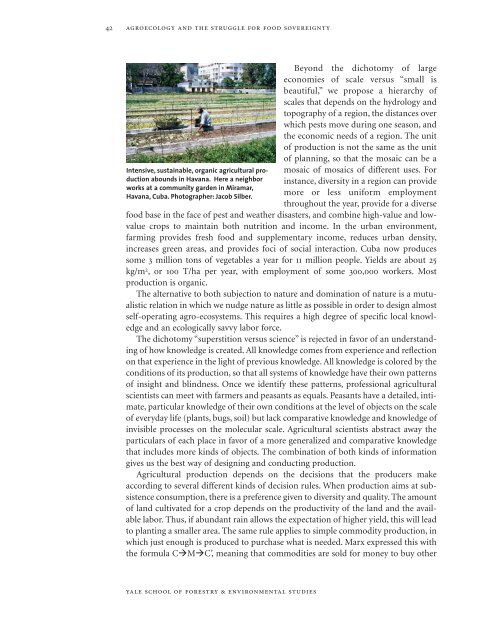Agroecology and the Struggle for Food Sovereignty ... - Yale University
Agroecology and the Struggle for Food Sovereignty ... - Yale University
Agroecology and the Struggle for Food Sovereignty ... - Yale University
Create successful ePaper yourself
Turn your PDF publications into a flip-book with our unique Google optimized e-Paper software.
42<br />
agroecology <strong>and</strong> <strong>the</strong> struggle <strong>for</strong> food sovereignty<br />
Intensive, sustainable, organic agricultural production<br />
abounds in Havana. Here a neighbor<br />
works at a community garden in Miramar,<br />
Havana, Cuba. Photographer: Jacob Silber.<br />
Beyond <strong>the</strong> dichotomy of large<br />
economies of scale versus “small is<br />
beautiful,” we propose a hierarchy of<br />
scales that depends on <strong>the</strong> hydrology <strong>and</strong><br />
topography of a region, <strong>the</strong> distances over<br />
which pests move during one season, <strong>and</strong><br />
<strong>the</strong> economic needs of a region. The unit<br />
of production is not <strong>the</strong> same as <strong>the</strong> unit<br />
of planning, so that <strong>the</strong> mosaic can be a<br />
mosaic of mosaics of different uses. For<br />
instance, diversity in a region can provide<br />
more or less uni<strong>for</strong>m employment<br />
throughout <strong>the</strong> year, provide <strong>for</strong> a diverse<br />
food base in <strong>the</strong> face of pest <strong>and</strong> wea<strong>the</strong>r disasters, <strong>and</strong> combine high-value <strong>and</strong> lowvalue<br />
crops to maintain both nutrition <strong>and</strong> income. In <strong>the</strong> urban environment,<br />
farming provides fresh food <strong>and</strong> supplementary income, reduces urban density,<br />
increases green areas, <strong>and</strong> provides foci of social interaction. Cuba now produces<br />
some 3 million tons of vegetables a year <strong>for</strong> 11 million people. Yields are about 25<br />
kg/m 2 , or 100 T/ha per year, with employment of some 300,000 workers. Most<br />
production is organic.<br />
The alternative to both subjection to nature <strong>and</strong> domination of nature is a mutualistic<br />
relation in which we nudge nature as little as possible in order to design almost<br />
self-operating agro-ecosystems. This requires a high degree of specific local knowledge<br />
<strong>and</strong> an ecologically savvy labor <strong>for</strong>ce.<br />
The dichotomy “superstition versus science” is rejected in favor of an underst<strong>and</strong>ing<br />
of how knowledge is created. All knowledge comes from experience <strong>and</strong> reflection<br />
on that experience in <strong>the</strong> light of previous knowledge. All knowledge is colored by <strong>the</strong><br />
conditions of its production, so that all systems of knowledge have <strong>the</strong>ir own patterns<br />
of insight <strong>and</strong> blindness. Once we identify <strong>the</strong>se patterns, professional agricultural<br />
scientists can meet with farmers <strong>and</strong> peasants as equals. Peasants have a detailed, intimate,<br />
particular knowledge of <strong>the</strong>ir own conditions at <strong>the</strong> level of objects on <strong>the</strong> scale<br />
of everyday life (plants, bugs, soil) but lack comparative knowledge <strong>and</strong> knowledge of<br />
invisible processes on <strong>the</strong> molecular scale. Agricultural scientists abstract away <strong>the</strong><br />
particulars of each place in favor of a more generalized <strong>and</strong> comparative knowledge<br />
that includes more kinds of objects. The combination of both kinds of in<strong>for</strong>mation<br />
gives us <strong>the</strong> best way of designing <strong>and</strong> conducting production.<br />
Agricultural production depends on <strong>the</strong> decisions that <strong>the</strong> producers make<br />
according to several different kinds of decision rules. When production aims at subsistence<br />
consumption, <strong>the</strong>re is a preference given to diversity <strong>and</strong> quality. The amount<br />
of l<strong>and</strong> cultivated <strong>for</strong> a crop depends on <strong>the</strong> productivity of <strong>the</strong> l<strong>and</strong> <strong>and</strong> <strong>the</strong> available<br />
labor. Thus, if abundant rain allows <strong>the</strong> expectation of higher yield, this will lead<br />
to planting a smaller area. The same rule applies to simple commodity production, in<br />
which just enough is produced to purchase what is needed. Marx expressed this with<br />
<strong>the</strong> <strong>for</strong>mula CMC’, meaning that commodities are sold <strong>for</strong> money to buy o<strong>the</strong>r<br />
yale school of <strong>for</strong>estry & environmental studies

















